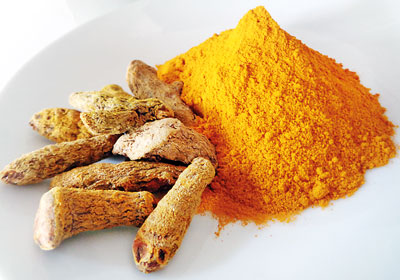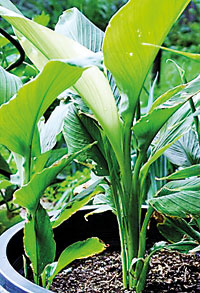Golden-hued wonder spice
Will a curry be a curry without its bright yellow hue? Imagine how bland our curries would look without turmeric – “the gold of spices”. But, turmeric is more than colour, this ever potent spice has a very interesting taste and aroma and is also associated with a range of beneficial biological functions.
It is also indispensable in Ayurvedic medicine. Turmeric, Curcuma longa, kaha in Sinhalese and manjal in Tamil in the ginger family Zingiberaceae, is a rhizomatous plant that is grown in wet and intermediate zones of Sri Lanka as a mono crop and an inter crop under coconut. Major growing districts are Kurunegala, Gampaha, Kalutara, Kandy and Matale.
 Using Turmeric
Using Turmeric
Fresh Turmeric – If you grow it then you have it, but if you are purchasing, choose firm plump rhizomes. Its wonderfully bright orange flesh is earthy, peppery and slightly bitter. The rhizomomes can be stored in the refrigerator in a plastic bag wrapped loosely for a week or two, or can be frozen for several months. However, it cannot beat the shelf life and overall utility of ground turmeric.
Dried Turmeric – is made by boiling and drying the fresh rhizomes. Boiling is required to remove the raw odour, reduce the drying time, gelatinize the starch and produce a more uniformly coloured product that can vary from yellow to orange. It has a rich woody aroma with floral, citrus and ginger notes. Dried turmeric can be stored in an airtight container in a cool, dark place for up to a year.
Ground Turmeric -is the most widely used form of turmeric and is made by grinding the dried turmeric. The potency of ground turmeric can be retained for up to six months when packed in airtight containers and kept in a cool place away from sunlight.If not stored properly, the colour properties will remain but the flavour and aroma will be lost.
Turmeric components
Turmeric owes its bright yellow colour to polyphenolic pigments known as curcuminoids of which the most active constituent is curcumin. This has powerful antioxidant and anti-inflammatory properties.The curcumin content in powdered turmeric varies from about 2 to 5%.The important flavour component in turmeric which is also reported to have anti-inflammatory ability is a volatile essential oil that is present in the range of 5 to 6% in the dried rhizome.
Curcumin absorption
Curcumin the active component in turmeric is not easily absorbed in our body. Fortunately, there are 3 simple kitchen strategies that you can use to boost turmeric bioavailability. Mixing with freshly ground black pepper that contains piperine will enhance absorption by 20 times. Turmeric can also be activated by heating for about 10 minutes or by mixing with healthy fat. So always add turmeric at the beginning of the cooking process and sauté with other aromatics such as onions, ginger and garlic to enhance absorption.
Culinary uses
The culinary uses of turmeric are endless. Fresh rhizomes can be sliced, chopped or grated and can be juiced, thrown into smoothies, added to pickles, salad dressings, curries, stir fries or into yoghurt and relishes. Ground turmeric gives a brilliant golden colour to rice, curries, soups, sauces and stews. It is a key ingredient in masalas, curry powders and pastes. You can even add a pinch of turmeric to your scrambled egg, sautéed vegetables and greens, pancake and quiche mixes, mac and cheese or even into your mug of tea or smoothie. It is widely used as a colourant for cheese, margarine, mustards, pickles, ice cream, cereals, yoghurt and yellow cake mixes. The latest addition to the turmeric ‘cook off’ is the turmeric latte that is fondly called ‘golden milk’.
Health benefits Decreases Inflammation
One of the most well-known applications of turmeric is as an anti-inflammatory agent. For this reason, turmeric helps reduce inflammation and eases pain in osteoarthritis, rheumatoid arthritis, gout, and muscle pain following exercise or injury.
Boosts immune system
Turmeric is a natural way to help bolster the immune system by increasing the immune-modulating capacity of the body. Try adding extra turmeric into your diet during periods of stress or during the flu season to help give your immune system a little boost.
Promotes digestive health
Turmeric can reduce symptoms of indigestion and dyspepsia by promoting the production of bile. Studies have also revealed that turmeric can relieve gas and bloating.
Keeps skin healthy
Turmeric helps keep your skin healthy by keeping pimples at bay. The curcumin in turmeric with high antioxidant properties fights signs of aging such as wrinkles and pigmentation by curbing the growth of free radicals.
Detoxifies body
Turmeric and its active compounds improve liver function and reduce the levels of toxicity in the body by stimulating the lymphatic system and ensuring that toxins are removed efficiently.
Increases memory function
As a powerful antioxidant that neutralizes free radicals and stimulates the body’s own antioxidant enzymes, turmeric can stimulate neural activity and prevent cognitive degradations, which often come in the form of Alzheimer’s and dementia.
Reduces stress and depression
Curcumin in turmeric has effects on hormone imbalances in the body and studies have shown that it is effective on patients suffering depression, mood swings, anxiety and stress.
Enhances heart health
Compounds present in turmeric help to lower low-density lipoprotein, or “bad,” cholesterol levels. It also improves the function of the endothelium as it is a potent anti-inflammatory agent and antioxidant.
Manages diabetes
In addition to correcting causes of diabetes, curcumin in turmeric has been proven to help reverse many issues related to insulin resistance and hyperglycemia.
Fights cancer cells
As curcumin is a powerful antioxidant it protects cells from oxidative damage, which is a risk factor for cancer. This makes turmeric a wonderful addition to any diet as a preventive measure and for slowing of cancerous growth.
Getting health benefits of turmeric
The day-to-day use of turmeric in our food contributes towards a disease preventive regime. However if you need to use curcumin to help your body fight a disease, you’ll need a lot more curcumin than it is possible to obtain by just using turmeric in cooking. It is only possible to get that amount of curcumin by taking turmeric tablets or capsules as a dietary supplement. Only purchase those with substantial amounts of the active components with added piperine.
 Grow your own Grow your ownYou can easily grow turmeric in a pot or in the ground, in a not too sunny place. Get some fresh rhizomes, break the large rhizomes into small pieces with each one having 2 or 3 buds and place about 2 inches below a light and loamy soil rich in organic matter. Always keep the soil moist.You can harvest in about 8 to 10 months when the leaves become yellow. Simply dig up the plant entirely, including the roots, cut the required amount and then replant the remaining part to get a new plant growing. | |


